Building out a truly omnichannel customer service strategy is crucial when it comes to delivering the kind of experience today’s customers expect. But what does omnichannel customer support actually look like?
Author: Adam Bunker
Subject Matter Expert: Brandon Hanson
What is omnichannel customer service?
Omnichannel customer service is offering people support across every possible channel and touchpoint – and doing so in a completely seamless, joined-up way.
In practice, that means allowing customers to take the customer support journey that best suits them, even if that means jumping from one channel to the next. If someone posts on X that they’ve encountered a problem, for example, it might be more convenient for them to solve it using an IM chat session, or via text. An omnichannel customer journey allows them to do that without repeating themselves.
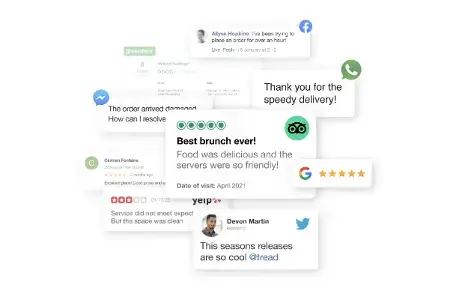
But it also means never missing an opportunity to help a struggling customer out – a true omnichannel customer service strategy means monitoring every single channel (owned and third-party) for potential issues and proactively reaching out.
Behind the scenes, omnichannel customer service requires software that can bridge the gaps between all these touchpoints to provide customer service agents with a cohesive, all-encompassing view of each customer’s support history.
Free eBook: Making the business case for contact center transformation
Omnichannel vs multichannel
Multichannel customer service usually means relying on several key touchpoints to try and filter customers through when dealing with issues. The more channels you can offer, the better, but where a multichannel approach can fall down is when those independent touchpoints are disconnected.
That disconnect often results in customers feeling unheard when they move from one channel to the next and have to repeat themselves or have to explain their issues repeatedly.
Omnichannel means connecting touchpoints in a unilateral, consistent customer service strategy. It means treating each touchpoint as an equal, vital part of the customer support journey, and leveraging insights from each to spot trends and proactively close experience gaps.
Benefits of omnichannel customer service
Offering excellent customer service has never been more important. Customers have more choice than ever – and switching brands is simpler than ever – so customer service offers a vital opportunity for differentiation.
In fact, research shows that 88% of customers say that these experiences are as important as the products a company has to offer. Fail on this front, and you’ll experience churn. Around a third of customers say that having to repeat information to customer service agents is the most frustrating part of their experience – and companies with poor omnichannel experiences only retain a third of their customers.
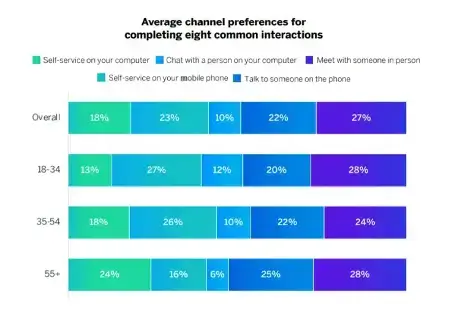
But for those businesses that do offer strong omnichannel customer support, customer loyalty tends to follow – with retention increasing to 89%.
Besides all that, implementing an omnichannel customer service strategy brings with it a raft of business benefits:
1. Streamlined issue resolution
By uniting customer data from every touchpoint, customer service teams benefit from insight that can help solve issues more quickly, reducing both time and cost to serve. If a customer moves from one channel to another without having to start their interaction from scratch, their issue can be handled smoothly as one cross-touchpoint interaction.
2. Trend analysis
Building bridges between otherwise disparate touchpoints allows businesses to map customer issues and sentiment in a much more thorough way – turning the contact center into a hub for customer experience insights. The benefit here is that emerging issues will be easier to spot.
If, as a simplified example, a software bug has been reported by one customer per channel, teams working independently from one another won’t realize it’s a widespread issue. But with a contact center management tool that spans and unites every channel, frontline teams can be alerted to the fact that a bunch of customers are reporting the same issue at once. This will let them flag emerging issues to the CX team before they have a chance to become more widespread reputational risks.
3. Personalized experiences
Using customer service and contact center tools that create a cohesive link between channels can also help brands offer more unified, personalized customer experiences. If, for example, a customer service agent is imbued with holistic, contextual information about a customer’s history, they’ll be able to reference past issues or purchases in a way that makes the customer feel listened to, understood, and valued.
4. Greater customer satisfaction
Customers who have their support queries solved quickly, easily, seamlessly, and on the channels that matter to them are much more likely to leave feeling satisfied with how things went. Offering best-in-class omnichannel customer service is a great way to differentiate your business from the competition in a battleground that really matters to customers. If every part of the customer journey feels unified and platform agnostic, you’ll naturally drive customer satisfaction and, in turn, loyalty.
The necessity of an omnichannel customer service program
Today’s customers expect not to have fractured, fragmented journeys. The expectation instead is that companies will be able to identify and follow them across any touchpoint they choose without friction.
Customers are now used to the idea businesses use software to enable more seamless customer journeys. We’re all presented with cookie policies on websites and we’re all aware of the idea that businesses track much more than just sales. These concessions are made as a trade-off; the more companies know about their customers, the more streamlined the customer experience should become as a result. And customer service is no different.
Salesforce research suggests that three-quarters of customers now expect fully consistent interactions that span departments, while Zendesk suggests over 35% of customers expect to be able to speak to the same customer service reps on any channel.
Omnichannel customer service allows businesses to meet these expectations by using customer data to bridge the gaps inherent to journeys that span multiple channels.
Optimizing cost while amplifying experience
Omnichannel customer service is both a great way to keep customers happy and an operational efficiency win. The process normally involves bringing all your customer support streams under one digital roof, which can help in a couple of key ways:
- Prioritization
True omnichannel customer service means having channels where customers can self-serve, as well as channels that can handle queries on an automatic basis – like AI-powered chatbots – working alongside human agents.
The result is that your contact center can begin to prioritize customer queries almost by itself; these other touchpoints and streams can distribute some of the workload, freeing up agents for the queries that definitely need a person on the end of the phone.
- Reducing repeat contact
A digital contact center that comprehensively tracks customer calls, texts, emails, IMs, and social media posts across touchpoints transforms those separate instances into one long, interweaving string of interactions. This ultimately helps issues get solved faster, with less repetition and less need for callbacks.
Developing an omnichannel customer service strategy
Building an omnichannel customer service strategy relies on being able to understand where your customers are, where they want to be, the journeys they take, and the tools you’ll need to bridge all those experiences and touchpoints.
There are four main steps to this process:
1. Map your customer journeys
2. Gather insights
3. Invest in the right technology
4. Learn and refine
Let’s take a look at each one in turn, and explore what it really takes to build a seamless customer experience through modern, connected customer service:
1. Map your customer journeys
If you want to be able to cater to every channel under the ‘omnichannel’ banner, you first need to understand customer preferences. Customer journey mapping is a great start here. It involves building out customer personas that you can send along hypothetical customer journeys.
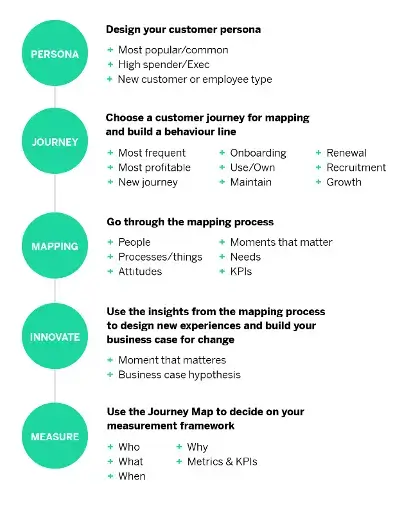
Gather stakeholders from across customer experience and see how many of these journeys you can map out. You’ll be surprised at just how many touchpoints you’ll realize the average customer may want to use at any given stage of their journey.
Here’s our ultimate guide to customer journey mapping to get you started.
2. Gather insights
Customer journey maps are a great tool, but they can only get you so far. Actual customer data can help you go further – and you can gather this from a variety of sources. First, ask your various teams for their qualitative input.
Are there channels and touchpoints they feel are being underserved based on data from the tools they have? How does that align with customer behavior data points within the contact center? Are there outliers? Do customers tend to start on one channel more than others? These findings will help you build a picture of journey flows that need to be catered to.
You can also ask customers directly. Soliciting feedback on your current customer service offering can help shine a light on channels and areas where things are lacking, as well as which touchpoints are high priority.
3. Invest in the right technology
Omnichannel customer service simply isn’t possible without a contact center management tool that can scour every channel, listen to and understand conversations, and build a holistic understanding of each customer’s history.
It’s these abilities that drive truly multimodal customer support, and it’s the insights that you’ll garner from offering this at scale that will continue to be transformative for the overall customer experience. To that end, you’ll need customer service software imbued with AI and natural language processing, alongside social listening features and the ability to prompt human agents with suggestions formed from customer data.
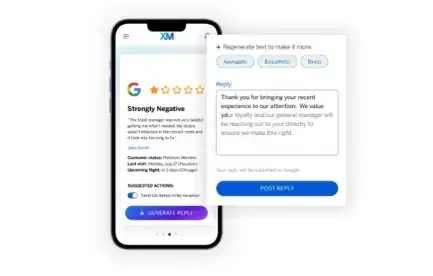
Qualtrics’ Customer Care Software, for example, equips agents and managers with AI-powered insights and tools that ingest and analyze data from every single channel and touchpoint – using what it learns to uncover what’s driving low-score customer reviews as well as offering personalized response suggestions that help customer care teams quickly resolve issues – helping them build stronger relationships.
4. Learn and refine
Building an omnichannel customer service strategy is far from a one-time process. It’s about constant iteration and improvement based on ongoing data collection, acting on insights, and feeding what you learn up the chain to the people designing the front end of the overall customer experience.
Customer support is an ever-evolving industry, so it pays to constantly monitor customer behavior, as well as agent and channel performance. Use what you learn to your advantage by better allocating resources, improving the customer-facing prompts and links between common connecting channels, and fine-tuning your customer journey mapping.
Omnichannel customer service examples
Need to see all this in action? Here are two hypothetical examples where omnichannel customer experience can really boost the customer experience – and help build lifelong customers…
Online banking: Omnichannel customer service
A customer is trying to set up a separate account, but the bank’s app isn’t responding. They write an angry post on X about the issue. An agent is automatically alerted to this, so they reply to the customer asking them to DM them the details. Following identification, an agent sends the customer an IM in the bank’s app to try and resolve the problem.
At the same time, the bank’s contact center management suite flags that multiple customer interactions seem to be about the same issue – across a bunch of different channels. This helps management raise a ticket with the development team to implement a fix.
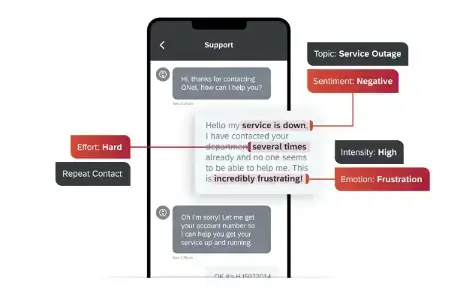
Mobile carrier: Omnichannel customer service
A customer gets billed twice in the same period in error. To solve this issue, they fire up the carrier’s mobile app on their way to work and start an IM chat with its digital assistant. The issue is more complex than the chatbot can handle by itself, so it automatically loops in a human agent to join the chat.
However, by this time the customer has reached work, so they ask to move the conversation to SMS so they can continue things over the course of the day without worrying that they’ll be booted from the chat. Once everything’s resolved, they get an email clarifying everything.
eBook: Making the business case for contact center transformation